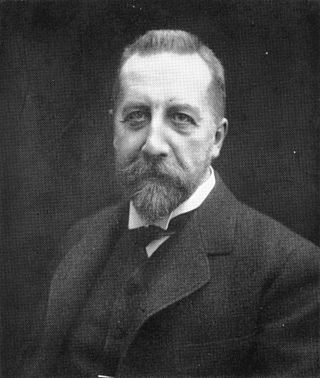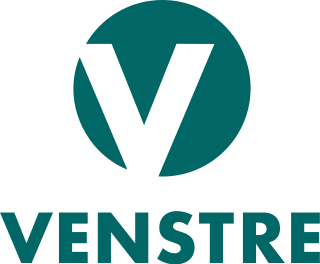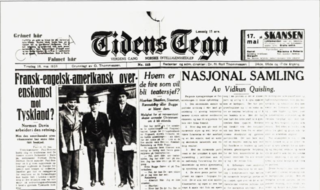The Liberal People's Party was a social liberal political party in Norway, established by a split in the Liberal Party over the issue of Norway's accession to the European Economic Community in 1972. The party was originally called the New People's Party until changing its name in 1980.

Johan Sverdrup was a Norwegian politician from the Liberal Party. He was the first prime minister of Norway after the introduction of parliamentarism. Sverdrup was prime minister from 1884 to 1889.

This article gives an overview of liberalism and radicalism in Denmark. It is limited to liberal and radical egalitarian parties with substantial support, mainly proved by having had a representation in the parliament. The sign ⇒ denotes another party in that scheme. For inclusion in this scheme it isn't necessary so that parties labeled themselves as a liberal party.
This article gives an overview of liberalism in Norway. It is limited to liberal parties with substantial support, mainly proved by having been represented in the Norwegian Parliament, Stortinget.

Peter Christian Hersleb Kjerschow Michelsen, better known as Christian Michelsen, was a Norwegian shipping magnate and statesman. He was the first prime minister of independent Norway and Norway's 9th prime minister from 1905 to 1907. Michelsen is most known for his central role in the dissolution of the union between Norway and Sweden in 1905, and was one of Norway's most influential politicians of his time.

Wollert Konow was the prime minister of Norway from 1910 to 1912. He was the leader of a coalition cabinet. Konow's time as prime minister saw the extension of accident insurance to seamen in 1911.

Jørgen Gunnarsson Løvland was a Norwegian statesman, educator and civil servant who served as the prime minister of Norway from 1907 to 1908. He belonged to the Liberal Party.
The Conservative Party or The Right is a liberal-conservative political party in Norway. It is the major party of the Norwegian centre-right, and was the leading party in government as part of the Solberg cabinet from 2013 to 2021. The current party leader is former Prime Minister Erna Solberg. The party is a member of the International Democracy Union and an associate member of the European People's Party.

The Liberal Party is a social liberal political party in Norway. It was founded in 1884 and is the oldest political party in Norway. Despite its native name, the Liberal Party is positioned in the centre on the political spectrum, and usually cooperates much more with the right wing parties. It is a liberal party which has over the time enacted reforms such as parliamentarism, freedom of religion, universal suffrage, and state schooling.

Johan Magnus Halvorsen was a Norwegian politician for the Free-minded Liberal Party.

Thomas Thomassen Heftye was a Norwegian military officer, engineer, sports official and politician for the Liberal Party. He is best known as the Norwegian Minister of Defence from June to October 1903 and March to April 1908, as well as the director of Telegrafverket. He was killed in the Nidareid train disaster.

Jakob Liv Rosted Sverdrup was a Norwegian bishop and politician. Born into a prominent local family and well-educated, Jakob followed in the footsteps of his father Harald Ulrik Sverdrup and his uncle Johan Sverdrup by pursuing both a theological and political life. He served five terms in the Norwegian Parliament between 1877 and 1898, and was a cabinet member on several occasions. Originally a member of the Liberal Party, he later joined the Moderate Liberal Party, having partially been the cause of the split that formed the Moderate Liberal Party. He has been referred to as "one of the most controversial figures in modern Norwegian history".
The Coalition Party was a Norwegian political coalition drawn from the Conservative Party, the Moderate Liberal Party and independent Liberals. Its main issues were opposition to the Liberal Party's political union radicalism, as well as to the rising growth of social democracy. Originally formed to pursue a more careful negotiating line towards Sweden, the party turned around and took part in Michelsen's Cabinet, which carried through the dissolution of the union between Norway and Sweden in 1905. The coalition's leading members included Christian Michelsen himself, Wollert Konow (SB) and Bjørnstjerne Bjørnson.
The Free-minded Liberal Party was a political party in Norway founded in 1909 by the conservative-liberal faction of the Liberal Party. The party cooperated closely with the Conservative Party and participated in several short-lived governments, including two headed by Free-minded Prime Ministers. In the 1930s the party changed its name to the Free-minded People's Party and initiated cooperation with nationalist groups. The party contested its last election in 1936, and was not reorganised in 1945.

Jon Gundersen Hol was a Norwegian engineer and activist. He is known for his pamphlet Rifleringen, published in February 1884, that resulted in his arrest for lèse majesté. In the pamphlet, he called for soldiers and civilians to arm themselves and encircle the Parliament of Norway Building, creating a "Ring of Rifles", should the need arise. The political situation in Norway at the time was unstable, with an ongoing impeachment case against the conservative government started by political liberals. King Oscar II of Sweden and Norway supported the conservative politicians, and Hol believed that a political and military counter-offensive was planned, hence the need for guarding the Parliament. The tensions between liberals and conservatives drew Hol into politics in the first place in 1880. Before this, he was an engineer by occupation and a writer, albeit apolitical. He increased his writing after 1880, and also involved himself in non-socialist trade unions, including the unsuccessful attempt of establishing a national trade union center in Kristiania.
Hans Larsen Saakvitne was a Norwegian farmer, bailiff and politician for the Liberal Party. He was mayor for several years, and served four terms as a regular representative in the Norwegian Parliament.

Tidens Tegn is a former Norwegian newspaper, issued in Oslo from 1910 to 1941.

Nils Vogt was a Norwegian journalist and newspaper editor. Born into a family of politicians and civil servants, he became the first chairman of the Norwegian Press Association and the Conservative Press Association. Vogt worked at the conservative newspaper Morgenbladet for 45 years, acting as editor-in-chief from 1894 to 1913. He wrote numerous articles during his lifetime, advocating independence from Sweden and the Riksmål standard of written Norwegian.
Centre was a political party in Norway founded in 1893 and led by Frits Hansen. It positioned itself as a moderate middle party between the Conservative Party and the radical Liberal Party.











